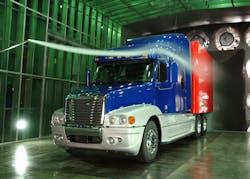UPDATED: Obama says next stage truck fuel efficiency standards will “save thousands”
President Obama today directed the Environmental Protection Agency (EPA) and the National Highway Traffic Safety Administration (NHTSA) to come up with new “next stage” fuel efficiency for heavy- and medium-duty trucks by March 2015, calling such standards the key to “saving thousands of dollars every year” in reduced fuel costs for trucking companies larger and small.
“This is not just a ‘win-win’ but a ‘win-win-win’ – three wins – in terms of driving down oil imports for our nation, reducing carbon pollution, and saving money for both businesses and consumers,” the President said in a speech at Safeway grocery chain distribution center in Upper Marlboro, MD.
“In 2011 we set new fuel efficiency standards for trucks and in my state of the union speech three weeks ago I said we’d build up on that,” President Obama noted. “The goal off these new fuel economy standards is to take us into the next decade like cars … so trucks use less oil, save money, and reduce pollution.”
The new “post-2018” standards will go beyond mandates crafted by EPA and NHTSA back in 2011 that are being applied to model year 2014-2018 light, medium, and heavy-duty trucks. A fact sheet released by the administration ahead of the President’s speech explained that the two agencies are expected to issue Notice of Proposed Rulemaking (NPRM) for the new “next-stage” fuel efficiency and greenhouse gas (GHG) standards by March 2015, with a final rule to be issued by March 2016.
The administration added that EPA and NHTSA will also work closely with stakeholders, both large and small, to explore further opportunities for fuel consumption and emissions reductions beyond the model year 2018 time frame, as well as with the California Air Resources Board (CARB) with the goal of ensuring that the next phase of standards allow manufacturers to continue to build a single national fleet.
The American Trucking Associations (ATA) is reacting positively yet cautiously to the President’s latest effort to mandate fuel economy improvements for heavy- and medium-duty trucks.
“Fuel is one of our industry’s largest expenses, so it makes sense that as an industry we would support proposals to use less of it,” noted Bill Graves, ATA’s president and CEO, in a statement. “However, we should make sure that new rules don’t conflict with safety or other environmental regulations, nor should they force specific types of technology onto the market before they are fully tested and ready.”
“Trucking is a very diverse industry,” stressed ATA Chairman Phil Byrd, president of Bulldog Hiway Express. “As such, whatever standards the administration sets should reflect that diversity and whatever tests are devised should accurately reflect what drivers face on the roads every day.”
By contrast, the Consumer Federation of America (CFA) believes that fuel efficiency improvements for big trucks could save the average American household $250 dollars per year in the cost of consumer goods and services.
“We know that the fuel costs associated with shipping goods cross country heavily impact the price of everything from a carton of milk to a pair of shoes. Achievable standards that cut fuel use by nearly 5% would put $29.5 billion dollars back into the pockets of Americans,” said Mark Cooper, CFA’s director of research; a figure drawn from the group’s recent report Paying the Freight: The Consumer Benefits of Increasing the Fuel Economy of Medium and Heavy-Duty Trucks.
“Consumers also pay the cost of commercial transportation fuel in the price of the goods and services they buy,” Cooper added. “As such, reducing the energy consumption of big truck fleets will have a positive impact on household expenditures.”
The Heavy Duty Fuel Efficiency Leadership Group (HDFELG), an informal collection of fleets and other industry participants formed back in 2010, is also endorsing the President’s “next-stage” fuel efficiency rule plan.
“Finalizing new fuel efficiency standards for medium and heavy duty trucks will be an important milestone that should result in significant benefits to our economy, the trucking industry and the environment,” noted Douglas Stotlar, president and CEO of Con-way Inc. and HDFELG member. “This collaborative approach will result in realistic, achievable goals and an effective regulatory framework to improve fuel efficiency and reduce greenhouse gas emissions.”
Dick Giromini, president and CEO of trailer-maker Wabash National Corp., added that for the first time, fuel efficiency and greenhouse gas emissions rules will likely cover the “trailer” part of tractor-trailers, setting standards designed to ensure that trailers contribute to better fuel efficiency and cuts in greenhouse gas emissions.
“We look forward to working with the EPA and the Department of Transportation, as well as our customers and industry partners, to achieve new standards that result in greater fuel efficiency and environmental benefits in the years ahead,” he said.
President Obama noted in his remarks that this latest effort to further improve heavy and medium-duty truck fuel efficiency is due to the “important economic role” performed by such vehicles.
“While heavy duty trucks account for just 4% of the vehicles on our highways – though I know when you are out there driving it feels like far more – they are responsible for 20% of our [vehicle] carbon pollution and 20% of one road fuel consumption,” he said. “Yet trucks carry over 70% of our nation’s freight – from flat screen TVs and diapers to fresh produce. So every mile per gallon better they get, that means thousands of savings every year for truckers and consumers.”
About the Author
Sean Kilcarr
Editor in Chief
Sean Kilcarr is a former longtime FleetOwner senior editor who wrote for the publication from 2000 to 2018. He served as editor-in-chief from 2017 to 2018.
